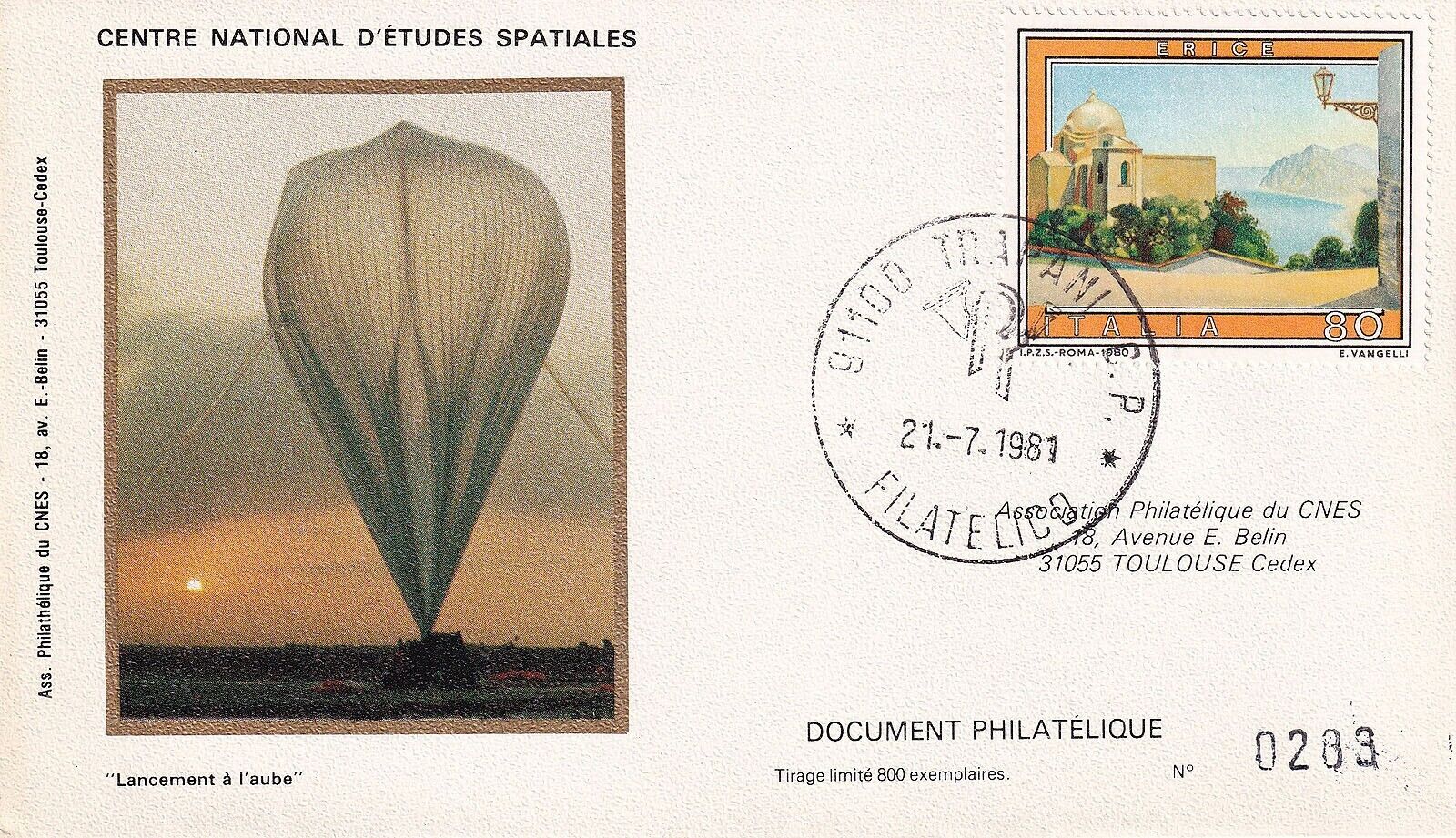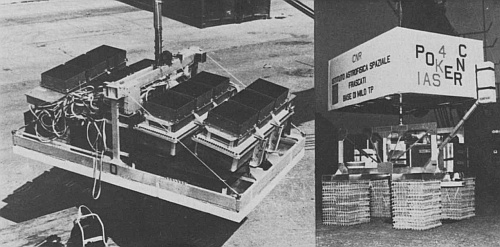Purpose of the flight and payload description
POKER was a balloon-borne instrument, designed and built at the Istituto di Astrofisica Spaziale of Frascati, Italy in the 80's devoted to perform observations of cosmic sources in the field of hard X-Ray Astronomy.
The core of the concept behind the experiment was a very large array of MultiWire Proportional Counters (MWPC). At left we can see images of the experiment before flight (click to enlarge). Each of the MWPC's has a geometrical area of 2.700 cm2 and was built into a modular structure. Externally, each counter was made of a rectangular stainless steel container (1200 mm x 450 mm x 180 mm), with a total volume of 97 litres and has an "Aeroweb" aluminium sandwiched honeycomb window corresponding to a total aluminium thickness of 400 micrometers. The structure was designed to withstand high pressure up to 10 bars. Internally, each chamber consisted of 5 layers and each layer had 12 anode wires, wired into a single modular frame. The anodes were separated by cathode grounded wires, which provided the wall-less ground geometry for each of the cell having dimension of 1100 mm x 30 mm x 30 mm. A 20 micrometer gold coated molybdenum wires were used as anodes while 40 micrometers molybdenum wires were used as cathodes. The side anodes and the bottom layer anodes in each counter were used as anticoincidence cells. This configuration provided the "bucket type" guard counter arrangement and drastically reduced the counter background counting rate. The counters were filled with a gas mixture of Xe + Ar + Isobutane (63% + 28% + 9%) at a combined pressure of 3 bars.
Since the aim of the first operative flight of this experiment, was the survey of the sky with high sensitivity and angular resolution, three of the four detectors were mounted looking to the meridian at a fixed elevation angle of 28º, 33º and 38º, and one of them was mounted with elevation angle of 33º and 5º off the azimuthal axis also. The platform was driven continuously to point North during the flight. Instantaneous direction of the telescope obtained by using a three axis flux-gate magnetometer was used to generate the error signal for the on-board closed loop servo control. The azimuthal control was achieved by torquing a heavy reaction wheel with respect to the gondola frame. In order to save some weight in the experiment was used as reaction mass a passive part of the gondola. The payload was kept suspended across a tube and was rotated by a d.c. torque motor with respect to the reaction mass.
Total weight of the experiment fully assembled in flight configuration was 1.400 kg.
Details of the balloon flight
Balloon launched on: 7/21/1981
Launch site: Base di Lancio Luigi Broglio, Trapani, Sicily, Italy
Balloon launched by: Agenzia Spaziale Italiana (ASI) / Centre National d'Etudes Spatiales (CNES)
Balloon manufacturer/size/composition: Zero Pressure Balloon Winzen 30.090.000 cuft (0.6 Mils - 2xCaps. 0.9 Mils - Stratofilm)
Balloon serial number: 424.70-0.6-NSCR 0.9 Caps. (2) SN:1
End of flight (L for landing time, W for last contact, otherwise termination time): 7/21/1981 at 21:30 utc
Balloon flight duration (F: time at float only, otherwise total flight time in d:days / h:hours or m:minutes - ): 16 h 02 m
Landing site: Near Llerena, 100 km N of Sevilla, Spain
Campaign: ODISSEA 81
Payload weight: 1.400 kgs
The balloon was released from the Milo base, Sicily, Italy in a Trans-Mediterranean flight on July 21, 1981 at 5:21 UTC and reached a ceiling altitude of 2.4 mbs at 8.30 UTC. The float level was maintained for a total duration of 13 hours until cut down over Spain at 21.30 UTC. The scientific and navigation data transmitted from the onboard telemetry system were continuously recorded by means of three different tracking stations in Milo (Launch base), Palma de Mallorca and Huelva (Spain).
During the flight, a large number of known X-ray sources, like 3C 129, MCG 8-11-11, NGC 4151, TWX-2, MK-421 and AO535 + 26 were detected in the field of view of the instrument. This mission served to demonstrate that the large area of the detectors array made POKER one of the most sensitive instruments so far employed for deep survey in the field of hard X-ray astronomy.
Postal cover issued on launch day commemorating the flight

External references
- Bilan de la campagne des vols de ballons transméditerranéens COSPAR Information Bulletin Vol.1982, Issue 93, Pag. 85
- Design and performance of a one square meter proportional counter system for hard X-ray astronomy Nuclear Instruments and Methods in Physics Research, Vol. 214, No. 2 - 3, p. 481
- Evidence of hard X-ray emission from three clusters of galaxies Astrophysical Journal, Part 1, vol. 279, April 15, 1984, p. 515
- Hard X-ray measurements of A0535+26 during low state In Max-Planck Inst. Phys. and Astrophys. Accreting Neutron Stars p 117-120
- Hard X-ray observations of the HER X-1 line feature In Max-Planck Inst. Phys. and Astrophys. Accreting Neutron Stars p 121
- Hard X-ray variability of three active galactic nuclei Astrophysical Journal, Part 1, vol. 284, Sept. 1, 1984, p. 54
- Hard X-rays emission from active galactic nuclei Advances in Space Research, Volume 3, Issue 10-12, p. 211
- Low state hard X-ray emission from A0535 + 26 Astronomy and Astrophysics, vol. 127, no. 2, Nov. 1983, p. 333
- New evidence of hard X-ray emission from 4U0515+38 Astronomy and Astrophysics, vol. 131, no. 2, Feb. 1984, p. 229
- Flight Summary of balloons made of Stratofilm - 1981 to 1983, Technical report, Winzen Research International. Circa 1984 - Stratocat's private collection
- Results from the HXR 81 M Hard X-Rays Sky Survey Experiment 18th International Cosmic Ray Conference, Bangalore, India, 1983. Volume 9, p.1
- Scientific balloons: historical remarks Memorie della Società Astronomica Italiana, v.79, p.783 (2008)
- The POKER experiment: A 10,800 cm2 MWPC's array payload for hard X-Ray Astronomy Advances in Space Research, Volume 3, Issue 4, p. 87
2045If you consider this website interesting or useful, you can help me to keep it up and running with a small donation to cover the operational costs. Just the equivalent of the price of a cup of coffee helps a lot.


